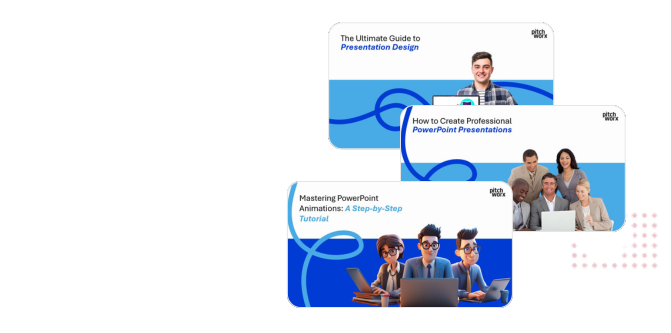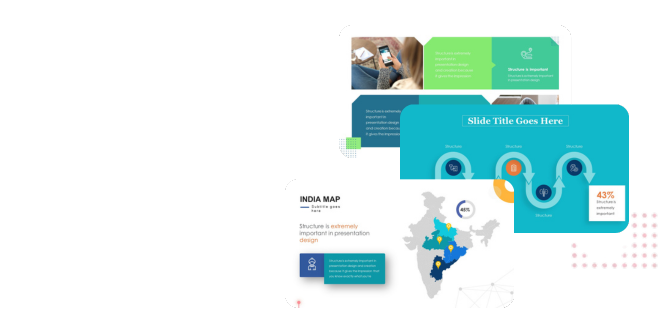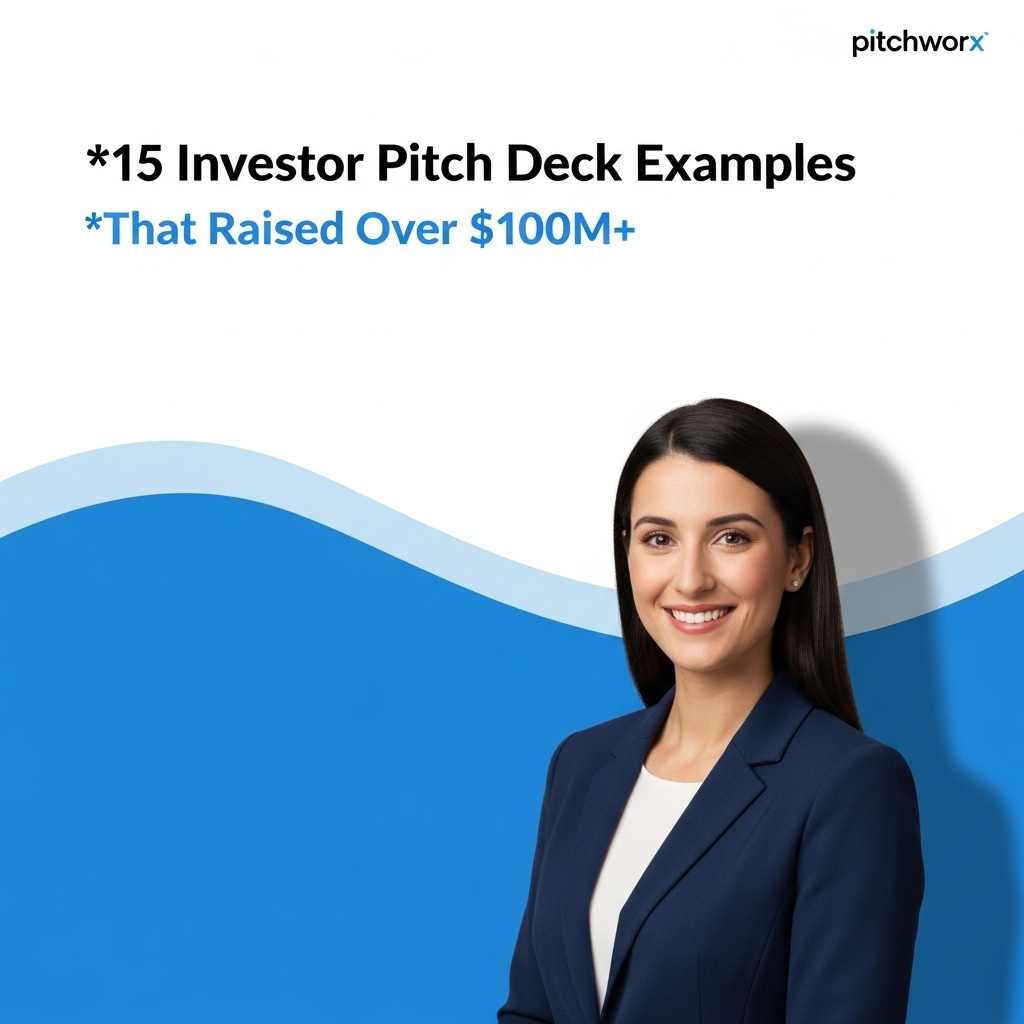Quick Answer
Investor pitch deck examples from legendary startups like Airbnb and Uber reveal essential patterns for successful fundraising. According to industry data, a professionally designed pitch deck can improve investor meeting success rates by up to 42%. Furthermore, clear visual storytelling can increase message retention by over 60%. To create a compelling deck, focus on three core areas: 1. A crystal-clear problem and solution narrative. 2. Data-driven validation of the market opportunity. 3. A professional design that builds credibility.
Table of Contents
- Introduction: The Blueprint to Billions
- The Anatomy of a $100M+ Pitch Deck: 4 Key Pillars of Success
- Deconstructing the Greats: Slide-by-Slide Analysis of 5 Iconic Pitch Decks
- Common Pitch Deck Mistakes That Cost Founders Millions
- About PitchWorx: Your Strategic Design Partner
- Frequently Asked Questions
- Conclusion: From Deck to Deal
Introduction: The Blueprint to Billions
Every unicorn startup that now dominates its market—from Airbnb to Uber to Peloton—once began as a simple idea articulated in a presentation. That presentation, the investor pitch deck, is arguably the single most important document in a startup’s early life. It’s more than a collection of slides; it’s the vessel for a founder’s vision, the narrative that transforms an idea into a tangible investment opportunity. A compelling deck doesn’t just ask for money; it commands attention, builds conviction, and persuades investors that they are looking at the future.
For over 13 years, our team at PitchWorx has designed and strategized thousands of presentations, witnessing firsthand what separates a deck that gets a polite “no” from one that sparks a bidding war. The difference often lies in the mastery of storytelling, the clarity of the data, and the professionalism of the design. In this comprehensive guide, we will deconstruct 15 legendary investor pitch decks that collectively raised billions. We won’t just show you the slides; we’ll dissect the underlying psychology and design principles that made them so effective, providing a blueprint for your own fundraising success.
The Anatomy of a $100M+ Pitch Deck: 4 Key Pillars of Success
After analyzing dozens of successful, high-stakes pitch decks, our agency has identified recurring patterns. These are not mere templates but strategic pillars that provide a solid foundation for any pitch. Winning decks are built on a compelling narrative, backed by undeniable data, communicated through thoughtful design, and centered on a clear, audacious vision.
Pillar 1: Master the Narrative (The Story That Sells)
Investors are human. Before they invest in a business model, they invest in a story. The most successful pitch decks frame the business as a classic narrative: a hero (the customer) faces a formidable villain (the problem), and your company provides the magic weapon (the solution). Airbnb’s seed deck is a masterclass in this. It didn’t sell “short-term rentals”; it sold the idea of “belonging anywhere.” According to Harvard Business Review, stories are up to 22 times more memorable than facts alone. This emotional hook is what makes your deck unforgettable long after the meeting ends.
- The Problem Slide: Make it relatable and urgent. Use a powerful image or a startling statistic to establish the pain point immediately.
- The Solution Slide: Present your solution with absolute clarity and simplicity. This is the “aha!” moment. Show, don’t just tell. Uber’s original deck famously presented the solution with a single tap on a smartphone.
- The Vision: Conclude with a grand vision. Show investors not just where you are, but the massive future you are building toward.
Pillar 2: Weaponize Your Data (The Logic That Convinces)
If story creates the emotional buy-in, data provides the logical justification. Every claim must be backed by evidence. The best decks use data not as a spreadsheet dump but as a visual tool for conviction. This means translating complex numbers into simple, powerful charts and graphs that scream “opportunity.” Decks like Square’s and Stripe’s excelled at this, taking a complex payments landscape and making their market entry point seem like an obvious, massive opportunity.
Key Data Slides to Perfect:
- Market Size (TAM, SAM, SOM): Don’t just state numbers. Use a top-down and bottom-up approach to show you’ve rigorously analyzed the opportunity. Visualize it with nested circles or a funnel to make the scale immediately apparent.
- Traction: This is your proof. A simple, steep upward-trending line chart showing user growth, revenue, or engagement is often the most powerful slide in a deck. If pre-launch, show waitlist numbers, survey data, or pilot results.
- Unit Economics (LTV/CAC): Show that your business model is sustainable and profitable at the single-customer level. A simple bar chart comparing Lifetime Value (LTV) to Customer Acquisition Cost (CAC) can instantly communicate a healthy business.
Pillar 3: Define Your “Unfair Advantage” (The Moat That Protects)
Investors aren’t just betting on a good idea; they’re betting on a defensible one. What prevents a competitor—or a giant like Google or Amazon—from crushing you once you’ve proven the market? This is your moat. Your deck must articulate this “unfair advantage” with conviction. LinkedIn’s early decks, for example, highlighted the power of their network effects—each new user made the platform more valuable for all other users, creating a powerful, self-perpetuating moat.
- Proprietary Technology: Do you have patents or unique algorithms?
- Network Effects: Does your product become more valuable as more people use it?
- Exceptional Team: Does your team have unique domain expertise that no one else has? This was a key slide for many deep-tech and biotech startups.
- Exclusive Partnerships or Data: Have you secured deals or access that competitors can’t replicate?
Pillar 4: Professional Design (The Signal of Quality)
A poorly designed deck signals a lack of attention to detail—a major red flag for investors. Professional design isn’t about flashy animations; it’s about clarity, credibility, and brand consistency. It ensures your powerful message isn’t lost in a sea of clutter. Every unicorn pitch, without exception, is clean, visually consistent, and easy to read. According to industry data from DocSend, investors spend an average of just 3 minutes and 44 seconds on a pitch deck. Your design must make every second count. This is where partnering with a specialized agency can provide a significant ROI, ensuring your first impression is one of quality and professionalism.
Deconstructing the Greats: Slide-by-Slide Analysis of 5 Iconic Pitch Decks
Let’s move from theory to practice. By dissecting the key slides from five legendary decks, we can extract actionable lessons for your own presentation. These examples are not meant to be copied, but to be understood as strategic communication tools.
1. Airbnb (Seed, 2008): The Power of Simplicity
Airbnb’s first deck is a testament to clarity. In just a few slides, it perfectly framed a novel idea in a way anyone could understand.
- The Lesson: The problem slide used just three simple bullet points: “Price,” “Hotels,” and “No local connection.” The solution slide mirrored this structure perfectly: “Save money,” “Make money,” “Share culture.” This 1:1 mapping made the value proposition instantly obvious.
- How to Apply It: Frame your problem and solution as two sides of the same coin. Use parallel language and structure to create an undeniable connection in the investor’s mind.
2. Uber (Seed, 2008): Selling a Future State
Then “UberCab,” the deck sold a vision of the future. It identified existing inefficiencies (taxi industry) and presented a technologically superior alternative that seemed inevitable.
- The Lesson: The deck masterfully outlined the “Best Case Scenario” and “Worst Case Scenario” for market size, showing a massive potential return even in a conservative outcome. It positioned itself not as a taxi company, but as a logistics and lifestyle brand from day one.
- How to Apply It: Paint a picture of the future your company will create. Show investors the scale of your ambition and anchor it with a conservative, realistic base case to build credibility.
3. Peloton (Series F, 2018): The Community and Content Moat
By its later rounds, Peloton’s deck was less about the bike and all about the ecosystem. It showcased a fanatical community and a powerful recurring revenue engine built on content.
- The Lesson: The deck was filled with metrics on engagement, low churn rates (high retention), and cohort data showing users became more valuable over time. The hardware (the bike) was framed as the entry point to a high-margin subscription service.
- How to Apply It: If you have a subscription or recurring revenue component, make it the hero of your financial story. Show how customer acquisition costs are paid back multiple times over, demonstrating the long-term value of your business.
4. Intercom (Series A, 2013): Product-Led Storytelling
Intercom’s deck brilliantly used its own product’s UI to tell the story. The slides themselves looked and felt like the Intercom platform, creating an immersive and authentic experience.
- The Lesson: The design wasn’t just decoration; it was a demonstration of the product’s elegance and user-centric philosophy. It showed investors the product’s value proposition without them ever having to log in.
- How to Apply It: Let your brand and product ethos shine through in your deck’s design. If your brand is about simplicity, your deck should be minimal. If it’s about data, it should be visually sharp and analytical.
5. Coinbase (Seed, 2012): Making the Complex Simple
In 2012, Bitcoin was a niche, complex, and often mistrusted technology. Coinbase’s challenge was to make it seem like a safe, simple, and inevitable part of the future of finance.
- The Lesson: The deck used analogies (“a hosted Bitcoin wallet”) and simple diagrams to demystify the technology. It focused on the user problem—”Bitcoin is hard to use”—and presented a clean, elegant solution, abstracting away the technical complexity.
- How to Apply It: If you are in a technical or complex field, your number one job is to simplify. Use analogies, clear visuals, and focus on the “what” and “why” before diving into the “how.” Assume your audience is smart but not an expert in your specific domain.
Common Pitch Deck Mistakes That Cost Founders Millions
In our 13+ years of experience at PitchWorx, we’ve seen brilliant ideas fail to get funded due to avoidable presentation errors. Learning from these mistakes is just as important as studying the successes. Here are the most common pitfalls we’ve observed.
The “Wall of Text” Syndrome
The Mistake: Slides packed with dense paragraphs and tiny fonts. Founders often do this because they want to include every detail, but it has the opposite effect. Investors won’t read it; they’ll just see clutter and assume the presenter can’t distill information effectively.
The Fix: Adhere to the “one idea per slide” rule. Use headlines as your main point and support them with concise bullet points or, even better, a powerful visual. Your spoken narration should fill in the details. The slides are a billboard, not a novel.
Vague, Unsubstantiated Projections
The Mistake: A “hockey stick” financial graph with no underlying logic. Showing massive revenue growth without explaining the assumptions behind it (e.g., marketing spend, conversion rates, sales cycle) screams amateurism.
The Fix: Your financial slide should be the tip of the iceberg. The projections themselves can be simple, but you must clearly state your key assumptions. For example: “We project $10M ARR in Year 3 based on a 2% conversion rate from a projected 5M site visitors, with a CAC of $50 and an LTV of $250.” This shows you’ve done your homework.
Neglecting the “Why Now?”
The Mistake: Presenting a great idea without explaining why this is the perfect moment for it to succeed. Investors want to know what market shift, technological advancement, or cultural change makes your solution viable and urgent right now.
The Fix: Dedicate a slide to “Why Now?” This could highlight trends like the rise of remote work, a new regulation, the ubiquity of smartphones, or a shift in consumer behavior. This creates a sense of urgency and shows you have a keen sense of market timing.
About PitchWorx: Your Strategic Design Partner
With over 13 years of specialized experience and more than 150,000 slides designed, PitchWorx is an ISO 27001 certified presentation design agency. We are the trusted partner for Fortune 500 companies, startups, and business leaders across the United States, India, and the UAE. Our team’s deep expertise in sectors like technology, healthcare, and finance ensures that your story is not only beautifully designed but also strategically sound and positioned to win.
Related Services
Frequently Asked Questions
What are the 10 essential slides for an investor pitch deck?
While it can vary, a classic investor pitch deck includes these 10 slides: 1. Cover/Intro, 2. Problem, 3. Solution, 4. Market Size, 5. Product/Demo, 6. Traction/Progress, 7. Business Model, 8. Team, 9. Competition, and 10. The Ask/Financials. The key is to tell a logical and compelling story across these sections.
How long should an investor pitch deck be?
The ideal length for an investor pitch deck is between 10 to 15 slides. According to extensive industry research, investors spend very little time per deck, so brevity and impact are critical. This range is enough to convey your core message without overwhelming the audience. Decks longer than 20 slides often see a significant drop-off in reader engagement.
What’s the difference between a seed deck and a Series A deck?
A seed deck is primarily about the vision, the team, and the market opportunity. It sells the “dream” and aims to secure initial capital to find product-market fit. A Series A deck, however, is much more data-driven. It must prove product-market fit with hard metrics like revenue, user growth, unit economics (LTV/CAC), and low churn. The focus shifts from vision to proven traction and a repeatable growth model.
How important is design in a pitch deck?
Design is critically important. It’s the first signal of quality and professionalism. A clean, well-branded design builds credibility and trust before you even say a word. Poor design can make a great idea look amateurish and untrustworthy. It’s not about being flashy; it’s about clarity, readability, and ensuring your message is communicated effectively and memorably.
Should I include a valuation slide in my pitch deck?
Generally, no. It’s best to avoid putting a specific valuation in the deck you send out. Valuation is a conversation, not a declaration. Stating it upfront can anchor the negotiation unfavorably or price you out of consideration. Instead, focus your “Ask” slide on the amount of capital you’re raising and how you plan to use the funds to achieve specific milestones.
Conclusion: From Deck to Deal
The legendary pitch decks that built today’s tech giants were not created by accident. They were meticulously crafted instruments of persuasion, blending a powerful human story with undeniable data and professional design. They prove that a great idea is only as powerful as its ability to be communicated. By embracing the principles of narrative storytelling, data visualization, and strategic design, you can elevate your pitch from a simple presentation to a compelling investment thesis.
Your pitch deck is the first product your investors will experience. Investing the time, effort, and resources to make it world-class is not an expense; it’s an investment in your company’s future. Take these lessons, apply them with rigor, and build the deck that doesn’t just ask for a check, but inspires belief in your vision.
Ready to transform your vision into a deck that captivates investors? Our presentation design service helps businesses across the US, India, and UAE markets secure the funding they need to grow. View our portfolio to see results that drive action and close deals.










